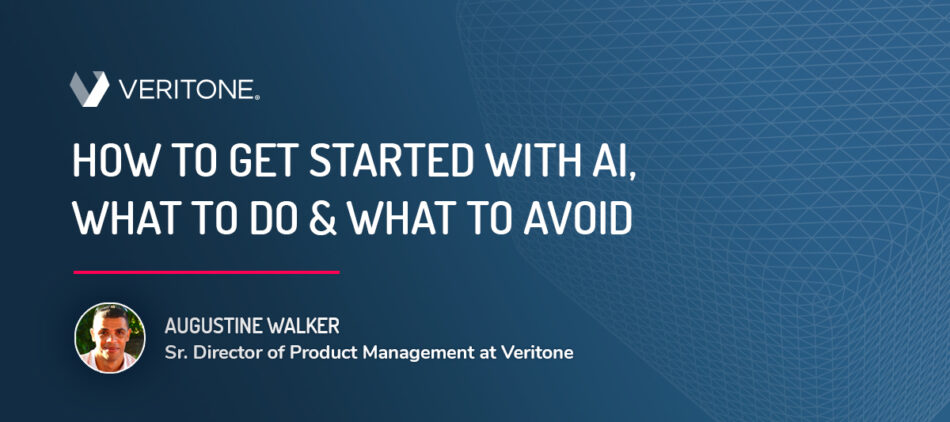
How to Get Started with AI, What to Do, and What to Avoid
Four practical considerations for a successful AI implementation
Earlier this month, our Sr. Director of Product Management Augustine Walker discussed with other thought leaders in the space how to start an AI initiative, best practices as well as what not to do.
Where should a company start when it comes to an AI project?
When starting an AI project, businesses need to define the problem they intend to solve and understand how AI could improve the processes that are in place. AI can seem like a magic bean that can solve all types of problems automatically but AI like any other technology has limitations.
After determining that AI can and should be applied, businesses need to evaluate which model to use. There are many available. For example, if a business is optimizing statistical financial, banking, insurance, or healthcare data, a Linear Regression model may be the most appropriate choice. When the AI is used to make decisions between two options, a Logistic Regression model can give appropriate outcomes based on binary classifications. Another model to keep in mind is the traditional Decision Tree that is best used for “if this, then that” decisions. A popular model for detecting and classifying objects within images is the Convolutional Neural Network. The right models can make or break AI projects so it is important to understand the problem first and work backward to select the algorithm that is appropriate for the data on hand.
What are areas to focus on?
Businesses need to understand the business problem that they are trying to solve and then focus on what data is available and accessible to them to help build an AI model to address it. When businesses fail to clearly understand and prepare the data they have, they fly into AI projects blindly. By taking a data-first approach, businesses can build tools and systems that are meaningful. When businesses have a thorough plan for how they will leverage their data in place, they will be able to hit the ground running when they bring on additional resources and tools to build AI projects.
What should they avoid?
- When working with data in AI projects, it’s important to avoid building AI models that succumb to confirmation bias. This can be avoided by challenging assumptions and testing if the outcome is what is expected by ensuring the data used to build the model has examples that are representative of as many as possible of the scenarios it will encounter when implemented for the business.
- Many organizations go wrong when they try to build from the ground up. There’s no need to reinvent the wheel and a lot of tools are out there to help accelerate the process of AI development such as pre-existing Machine Learning models that can be modified to fit the scenario as needed. Building it from the ground up takes additional development time and costs. Instead, businesses can find a platform or service, and also existing Machine Learning Models such as aiWARE Machine Box Engines, which Veritone offers, to help develop and get their AI system up and running quickly to accelerate learning and reduce cost.
- Businesses need to avoid building black boxes. There are instances where models may act, but how the model arrived at its decision is unclear. It’s important to fine-tune models and more importantly make them explainable to reduce anxiety around AI. When AI teams can describe their AI processes to their partners, customers and other teams across the business, they will have more confidence in it.
- Trusting too much in AI can be dangerous. There may be edge cases that an AI process may not be able to address, or scenarios it’s unequipped to handle, so it is important to have a back-up plan in place to supplement the AI in the event that the business needs to operate without it. Businesses need to be open to constantly evaluating and learning from their processes to retrain or build stronger models as they encounter these conditions.
Why does in house AI fail?
AI fails when businesses don’t have the appropriate resources available. Businesses need to pair a data scientist that’s experienced at building AI models with a business analyst or operations professional that understands the intricacies of the business. Including a software engineer that can ensure proper data ingestion and model deployment is also part of the “nuts and bolts” needed to build a strong AI development team.
Often times businesses take on AI projects not realizing that it might have been cheaper to continue a process manually instead of investing large amounts of time and money into building a system that doesn’t save the company time or money.
Many AI projects encounter challenges when scaling up. For example, the process might work with one or two thousand simultaneous requests but may not have the infrastructure to scale up to a million or more. Horizontal and vertical scaling platforms like Veritones aiWARE can help here.
Finally, businesses need to understand that an AI project is never truly finished and businesses need to devote teams that work on continuous improvement, monitoring, evaluating, and evolving the AI models. AI models make work one day, but that doesn’t mean they will continue to work without considering changing business conditions and maintenance could be put at risk as staff turns over. It’s very conceivable and common for them to encounter never-before-seen conditions that can cause the model to fail. Thus AI models are more resilient when they can be re-trained easily (i.e. fine-tuned). The aforementioned Machine Box engines from aiWARE support incremental model retraining which significantly reduces model re-training time.